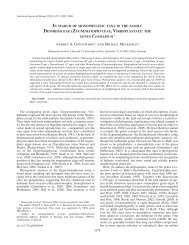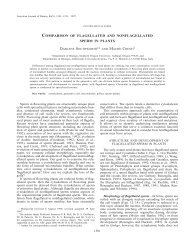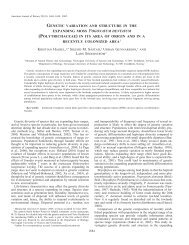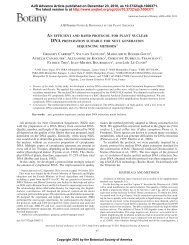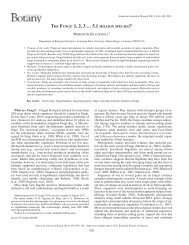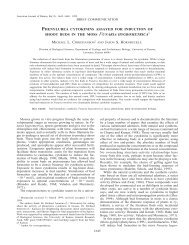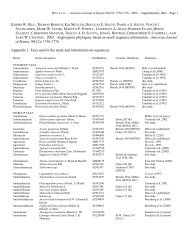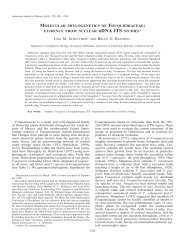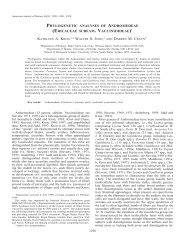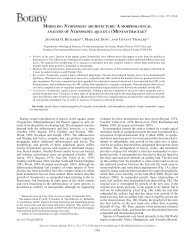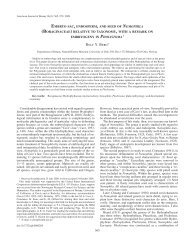Edward M. Peters, 2 Carlos Martorell, 3 and Exequiel Ezcurra 4,5
Edward M. Peters, 2 Carlos Martorell, 3 and Exequiel Ezcurra 4,5
Edward M. Peters, 2 Carlos Martorell, 3 and Exequiel Ezcurra 4,5
Create successful ePaper yourself
Turn your PDF publications into a flip-book with our unique Google optimized e-Paper software.
American Journal of Botany 96(2): 537–541. 2009.<br />
Serotiny or delayed dispersal — the retention of mature seeds<br />
within the maternal plant for more than one year — is a syndrome<br />
of adaptive signifi cance in r<strong>and</strong>omly fl uctuating enviroments<br />
such as dry, fi re-prone scrubs <strong>and</strong> forests (e.g., Lamont<br />
et al., 1991 ; Lamont <strong>and</strong> Enright, 2000 ; Midgley, 2000 ), <strong>and</strong><br />
arid ecosystems ( Ellner <strong>and</strong> Schmida, 1981 ; Kamenetsky <strong>and</strong><br />
Gutterman, 1994 ; Van Oudtshoorn <strong>and</strong> Van Rooyen, 1999 ). Serotiny<br />
can be adaptively advantageous through (1) early establishment<br />
within the germination season ( Went, 1949 ; Beatley,<br />
1974 ), (2) protection of seeds against granivores ( Reichman,<br />
1979 ; Van Oudtshoorn <strong>and</strong> Van Rooyen, 1999; Albert, 2005 ),<br />
(3) bet-hedging risks by spreading seed dispersal in time ( Cohen,<br />
1966 , 1968 ; Venable <strong>and</strong> Lawlor, 1980 ), <strong>and</strong> (4) retaining seeds<br />
in a favorable microhabitat ( Gutterman, 1994 , 1995 ).<br />
A special case of serotiny is found in many small globose<br />
cacti ( Anderson, 2001 ; Rodr í guez-Ortega et al., 2006 ). Bravo-<br />
Hollis <strong>and</strong> S á nchez-Mejorada (1991) described at least 25 species<br />
(belonging to the genera Mammillaria , Coryphantha ,<br />
Dolichothele , Neobesseya , Echinocactus , Aztekium , Lophophora<br />
, Obregonia , Ariocarpus , <strong>and</strong> Pelecyphora , all in the<br />
subtribe Cacteae within the tribe Cactoideae) that show some<br />
degree of fruit retention. The fl owers grow from meristems<br />
deep in wooly apices or in the folds between stem tubercles <strong>and</strong><br />
tend to sprout in coetaneous whorls near the top of the plant.<br />
The resulting fruits may be retained for up to six years.<br />
Working with three species of Mammillaria , Rodr í guez-<br />
Ortega et al. (2006) showed that one species growing in drier<br />
<strong>and</strong> more variable environments retained more seeds (ca. 25%)<br />
than other species that grow under milder <strong>and</strong> more constant<br />
1 Manuscript received 1 May 2008; revision accepted 21 October 2008.<br />
The authors thank S. Arizaga, E. Castillo, <strong>and</strong> the people at Texcala,<br />
Puebla, for their help. This paper is part of the graduate research of E.M.P.,<br />
supported by a CONACyT scholarship. The research was also funded by<br />
CONABIO project R-166, <strong>and</strong> the Instituto de Ecolog í a-UNAM provided<br />
logistic support.<br />
5 Author for correspondence (e-mail: exequiel@ucr.edu)<br />
doi:10.3732/ajb.0800157<br />
T HE ADAPTIVE VALUE OF CUED SEED DISPERSAL IN DESERT<br />
PLANTS: SEED RETENTION AND RELEASE IN MAMMILLARIA<br />
PECTINIFERA (CACTACEAE), A SMALL GLOBOSE CACTUS 1<br />
<strong>Edward</strong> M. <strong>Peters</strong>, 2 <strong>Carlos</strong> <strong>Martorell</strong>, 3 <strong>and</strong> <strong>Exequiel</strong> <strong>Ezcurra</strong> 4,5<br />
2 Direcci ó n de Conservaci ó n de los Ecosistemas, Instituto Nacional de Ecolog í a-SEMARNAT, Perif é rico Sur 5000 2 ° piso,<br />
Insurgentes-Cuicuilco 04510 M é xico D.F., Mexico; 3 Departamento de Ecolog í a y Recursos Naturales, Facultad de Ciencias,<br />
Universidad Nacional Aut ó noma de M é xico, Ciudad Universitaria, Coyoac á n 04510 M é xico D.F., Mexico; <strong>and</strong> 4 Department of<br />
Botany <strong>and</strong> Plant Sciences, University of California-Riverside, 900 University Avenue, Riverside, California 92521, USA<br />
Serotiny, or delayed seed dispersal, is common in fl uctuating environments because it hedges the risks of establishment. Mammillaria<br />
pectinifera (Cactaceae) facultatively expels fruits in the year they are produced or retains them to disperse the seed over<br />
several years. We tested whether M. pectinifera increased fruit expulsion as a response to increased rainfall. While no fruit expulsion<br />
was observed in 1997, a dry year, in the wetter 1998 around 20% of all fruits formed were expelled from the maternal plant.<br />
A greenhouse experiment showed that high moisture results in the plants expelling all their fruits. Because in 1998 establishment<br />
was fi ve times higher than in 1997, this response seems to be highly adaptive: Active fruit expulsion <strong>and</strong> consequent seed release<br />
increases the probability of establishment during pulses of high precipitation.<br />
Key words: bet-hedging; Cactaceae; environmental triggers; Mammillaria ; Mexico; serotiny; Tehuac á n Valley.<br />
537<br />
conditions (only ca. 5% retained). They concluded that serotiny<br />
in Mammillaria may be an adaptive trait that confers some advantage<br />
in harsh <strong>and</strong> unpredictable arid environments.<br />
However, fruit retention varies not only between individuals<br />
but also over time within a single plant. In this study we assessed<br />
whether a serotinous cactus can facultatively regulate<br />
the fraction of seeds that are retained. We worked with Mammillaria<br />
pectinifera F.A.C. Weber (Cactaceae), a rare <strong>and</strong><br />
threatened plant that has two modes of seed release: (1) Whole<br />
fruits may be released with their complete seed content immediately<br />
after maturation, while (2) other fruits are retained, <strong>and</strong><br />
they gradually release seeds through an apical aperture as they<br />
age ( Fig. 1 ). The ability of the plant to follow one or the other<br />
path may have adaptive value in response to climatic variability<br />
because the probability of establishment during wet pulses may<br />
increase ( Noy-Meir, 1973 ; Gutterman, 1995 ).<br />
This hypothesis is especially important because germination<br />
<strong>and</strong> establishment constitute the most vulnerable stages in the<br />
life cycle of cacti (e.g., Steenberg <strong>and</strong> Lowe, 1983 ; Valiente-<br />
Banuet <strong>and</strong> <strong>Ezcurra</strong>, 1991 ) <strong>and</strong> establishment of desert plants<br />
occurs mostly during pulses of high precipitation ( Evenari et<br />
al., 1971 ; Lacey, 1980 ; Holmgren et al., 2001; Bowers et al.,<br />
2004 ; Venable, 2007 ). Thus, while gradual seed release in serotinous<br />
cacti may be a bet-hedging strategy that spreads the risks<br />
of establishment, the sudden release of a large proportion of<br />
seeds may be of even greater advantage if the plants can in<br />
some reliable way synchronize the release with an environmentally<br />
favorable period ( Cohen, 1966 , 1968; Venable <strong>and</strong> Lawlor,<br />
1980 ). The driving question of our research was: Can serotinous<br />
plants adaptively regulate fruit <strong>and</strong> seed release according<br />
to environmental conditions? And, if they can, will this increase<br />
the probability of successful establishment?<br />
To answer these questions, we studied the role of seed retention<br />
<strong>and</strong> dispersal in M. pectinifera in the fi eld during two<br />
contrasting years <strong>and</strong> also under different experimental conditions.<br />
Through this study, we tested two hypotheses. If the<br />
probability of establishment is raised during wet pulses, we<br />
predict that fruit expulsion should increase in wet years. Further,<br />
we predict that, in fully optimal circumstances (only to
538 American Journal of Botany [Vol. 96<br />
Fig. 1. Photograph of Mammillaria pectinifera with fi ve whorls of fruits of different ages showing the possible fates of fl oral buds. (a) Flowers; (b)<br />
expelled fruit from the most recent whorl (only the gap between areoles is seen in the photo); (c) retained fruits from the previous whorl (over two years of<br />
age); (d) third whorl of fruits, three or more years of age, with eroded tips <strong>and</strong> most of the seeds dispersed; (e) the dry remains of a whorl of old empty<br />
fruits, clearly seen at the base of the photo but not drawn in the diagram. In this species, expelled fruits always belong to the most recent cohort.<br />
be realized under fi eld conditions in extraordinary occasions),<br />
the expulsion of fruits should be the dominant mode of seed<br />
dispersal.<br />
MATERIALS AND METHODS<br />
Description of the species <strong>and</strong> study site — Mammillaria pectinifera is a<br />
globose, hemicryptophytic cactus, 3 – 4 cm in diameter. The pectinate areoles<br />
possess white appressed spines that cover <strong>and</strong> shade the plant. The fl owers open<br />
in circular crowns around the apex. The fruit is a whitish berry that may be<br />
completely expelled or may remain inserted inside the stem of the plant, gradually<br />
releasing seeds for 7 – 8 years ( Boke, 1960 ; Bravo-Hollis <strong>and</strong> S á nchez-<br />
Mejorada, 1991 ) (Fig. 1). The species is endemic to the Tehuac á n Valley, a small<br />
semiarid area in the southeast of the State of Puebla, Mexico ( Bravo-Hollis <strong>and</strong><br />
S á nchez-Mejorada, 1991 ), <strong>and</strong> is confi ned to deep alkaline soils with relatively<br />
high surface stoniness <strong>and</strong> high water retention capacity, receiving ca. 400 mm<br />
of annual precipitation ( Zavala-Hurtado <strong>and</strong> Valverde, 2003 ). Our fi eld study<br />
was done near the town of Texcala, in a dense st<strong>and</strong> of M. pectinifera . As a result<br />
of its restricted distribution, specialized habitat, habitat destruction ( <strong>Martorell</strong><br />
<strong>and</strong> <strong>Peters</strong>, 2005 ), looting, <strong>and</strong> illegal trade, the species has been included in the<br />
Appendix I of the Convention on International Trade in Endangered Species<br />
(CITES, 2007), <strong>and</strong> in the Mexican Government’s endangered species list<br />
( SEMARNAT, 2002 ).<br />
Rainfall data — Rainfall data for the study period (June 1997 – May 1999)<br />
were collected with rainfall gauges in the fi eld. The long-term series used for<br />
comparison was obtained from the public databases of Mexico ’ s Weather Service<br />
(Servicio Meteorol ó gico Nacional, M é xico, D.F.).<br />
Seed release from embedded fruits <strong>and</strong> viability — Twenty plants were collected<br />
near the study site, <strong>and</strong> the seeds that were retained inside 615 fruits of<br />
known age were extracted <strong>and</strong> counted. Age was easily estimated because annual<br />
rings of fruits are readily distinguishable in the stem (see Fig. 1 ). Curves<br />
were fi tted through a log-linear regression minimizing a χ 2 error function<br />
( Crawley, 1993 ) to predict the number of seeds that remain in the fruits at different<br />
ages. The seeds extracted from the fruits were placed in Petri dishes with<br />
agar gel <strong>and</strong> incubated at 25 ° C <strong>and</strong> a 12-h photoperiod to estimate viability loss<br />
in the embedded seeds as the fruits age. Germination was counted after 30 d (no<br />
further germination was observed after this time).<br />
Fruit expulsion <strong>and</strong> seedling establishment in the fi eld — The area under<br />
study was delimited by a 238-m 2 polygon. Eighty-one adult individuals of different<br />
sizes were r<strong>and</strong>omly selected <strong>and</strong> marked. The number of fruits produced<br />
<strong>and</strong> number of fruits expelled were recorded every month for two years, from<br />
June 1997 (at the beginning of the summer monsoon season) to May 1999 (at the<br />
end of the spring drought). Seedlings were carefully searched for <strong>and</strong> marked on<br />
November of both years (once the monsoon season had ended, when seedlings<br />
are more easily found) in 55 r<strong>and</strong>omly chosen 1-m 2 quadrats. They were monitored<br />
monthly until May (the onset of the following monsoon season), <strong>and</strong> the<br />
number of survivors was then extrapolated to the whole study area (238 m 2 ).<br />
Experiment on fruit expulsion — To assess whether fruit expulsion occurs<br />
as a response to increased precipitation, we transplanted 30 adult individuals of<br />
M. pectinifera with recently formed fruits to a greenhouse <strong>and</strong> r<strong>and</strong>omly assigned<br />
them to an experimental watering treatment (2 plants /treatment) ranging<br />
from 0 to 30 mm of watering three times a week for 21 wk. The proportion of<br />
fruits expelled by each plant was fi tted against total simulated precipitation using<br />
logistic regression with a χ 2 error function. All curve-fi tting procedures<br />
were done using the GLIM 4.0 statistical package ( Francis et al., 1993 ).<br />
RESULTS<br />
Rainfall data — The fi rst year of our study (June 1997 – May<br />
1998) coincided with an unusually dry period for the region, in<br />
synchrony with the 1997 El Ni ñ o anomaly ( Caso et al., 2007 ).<br />
The second year (June 1998 – May 1999) corresponded with a<br />
relatively wet period, in synchrony with La Ni ñ a conditions. Precipitation<br />
during the fi rst year (267 mm) was ca. 40% lower than<br />
the 36-yr average for the region (424 mm), while during the second<br />
year, rainfall (817 mm) almost doubled the mean ( Fig. 2 ).<br />
Seed release from embedded fruits <strong>and</strong> viability — The number<br />
of seeds remaining inside the fruits decreased as the nonexpelled<br />
fruits aged within the plant ( χ 2 = 26.85 for the<br />
two-parameter loglinear model, df = 1, p < 0.0001). On average,<br />
42.6% of the seeds are retained in each fruit during the fi rst<br />
year. Seeds rarely occurred in retained fruits greater than 4 yr of
February 2009] <strong>Peters</strong> et al. — Serotiny in MAMMILLARIA<br />
Fig. 2. Precipitation in the study area in the Tehuac á n Valley, Mexico, during 1997 – 1998. Black circles show the measured monthly precipitation <strong>and</strong><br />
open symbols the 40-yr average. The monsoon season (June – September) is shown for both years. Note the low monsoon precipitation in 1997 under strong<br />
El Ni ñ o conditions, followed by intense monsoonal downpours in the late summer of 1998, when La Ni ñ a conditions prevailed in the Pacifi c coast of<br />
Mexico.<br />
age ( Fig. 3 ). On average, 46% of the seeds germinated regardless<br />
of their age ( χ 2 = 0.7, df = 1, p > 0.4); i.e., seeds did not lose<br />
viability as they aged inside the maternal plant.<br />
Fruit expulsion <strong>and</strong> seedling establishment in the fi eld — An<br />
average of 6.1 fruits per plant was produced every year. No<br />
signifi cant differences in fruit production were observed between<br />
years, but the fraction of fruits expelled did differ ( χ 2 =<br />
115, df = 1, p < 0.0001). During the dry 1997, no fruits were<br />
Fig. 3. Number of seeds in fruits of different ages inserted between<br />
the areoles of the mother plants of Mammillaria pectinifera . Confi dence<br />
intervals correspond to ± 1 SE. The broken line shows the fi t of the twoparameter<br />
log-linear model ( s = 30.5 × e − 0.77 t ), for a constant retention rate<br />
of 46% per year (e − 0.77 = 0.464; see the results section, “ Seed release from<br />
embedded fruits ” for signifi cance of the fi t).<br />
539<br />
expelled from the plant stems, <strong>and</strong> all seeds released into the<br />
environment came from embedded fruits. In contrast, 21.5% of<br />
all new fruits were expelled in 1998, in synchrony with the onset<br />
of the intense monsoon rains that fell during this year. Assuming<br />
that fruit production remains roughly the same over<br />
time <strong>and</strong> that fruit expulsion in the two dry years preceding<br />
1997 was negligible, we estimated the total number of seeds<br />
that were likely shed in 1997 (when no fruits were expelled)<br />
<strong>and</strong> in 1998 (when 21.5% of all new fruits were expelled). The<br />
high moisture of the second year was refl ected in the greater<br />
number of seedlings <strong>and</strong> the higher establishment success observed<br />
in 1998, fi ve times greater than in 1997 ( Table 1 ).<br />
Experiment on fruit expulsion — Under greenhouse conditions,<br />
watering signifi cantly increased the expulsion probability<br />
of fruits ( F = 78.77, P < 0.0001, df = 1, Fig. 4 ). When the simulated<br />
annual precipitation exceeded 1000 mm, almost all fruits<br />
were expelled from the plants.<br />
DISCUSSION<br />
As hypothesized by Rodr í guez-Ortega et al (2006), the retention<br />
of fruits containing seed <strong>and</strong> the protracted viability of seed<br />
suggest that adult plants of M. pectinifera are acting as a seed<br />
bank that regulates dispersal over time. While whole-fruit release<br />
is triggered by a form of predictive cueing during favorable<br />
seasons, fruit retention followed by gradual seed release<br />
may act as a bet-hedging strategy in a taxonomic group with<br />
extraordinarily high seedling mortality ( God í nez- Á lvarez et al.,<br />
2003 ).<br />
Compared to other mammillarias ( Rodr í guez-Ortega et al.,<br />
2006 ), M. pectinifera retains a very large proportion (~43%) of
540 American Journal of Botany [Vol. 96<br />
Table 1. Seed production <strong>and</strong> seedling establishment by Mammillaria<br />
pectinifera for the two study years within the 238-m 2 study plot.<br />
Establishment success (the probability of establishment of a dispersed<br />
seed) was estimated as the ratio of seedlings that germinated each year<br />
<strong>and</strong> survived the following dry season divided by the total number of<br />
seeds released in that year.<br />
Reproductive variable 1997 – 1998 1998 – 1999<br />
Seeds from embedded fruits 35 508 32 259<br />
Seeds from extruded fruits 0 7634<br />
Total seed production ( a ) 35 508 39 893<br />
Seedlings ( b ) 17 95<br />
Establishment success ( b / a ) ( ‰ ) 0.47 2.38<br />
its seeds in nonexpelled fruits during the fi rst year after they<br />
mature. However, if the 21% fruit expulsion rate observed during<br />
the wetter 1998 period is taken into account, the fraction of<br />
seeds from recent fruits being released in a good year may increase<br />
substantially. Precipitation acts as the environmental cue<br />
triggering fruit expulsion. From the adaptive point of view, it<br />
seems to be a reliable signal because the probability of germinating<br />
<strong>and</strong> establishing was fi ve times higher in the rainy year<br />
of 1998 than in the dry 1997. Our greenhouse experiment<br />
showed that when moisture conditions are optimal, the plants<br />
may risk their full fruit production.<br />
We conclude that M. pectinifera has two well-defi ned seed<br />
dispersal mechanisms: (1) passive dispersal of seeds retained in<br />
the stem <strong>and</strong> (2) active expulsion of new fruits formed during<br />
the previous reproductive season. The way in which these two<br />
processes operate seems to depend on the amount <strong>and</strong> timing of<br />
precipitation ( Evenari et al., 1971 ; Noy-Meir, 1973 ). Under<br />
normal conditions, fruit retention prevails because whole-fruit<br />
expulsion requires precipitation well above the local average.<br />
These anomalies are linked to rare variations in climatic conditions<br />
<strong>and</strong> the ability to take advantage of them gives the plants<br />
a signifi cant increase in seedling establishment.<br />
Cohen (1968) showed that a strategy in which only a fraction<br />
of seeds germinate <strong>and</strong> the rest remain dormant maxi-<br />
Fig. 4. Fraction of fruits of Mammillaria pectinifera expelled as a<br />
function of increased watering under greenhouse conditions, <strong>and</strong> logistical<br />
regression describing the threshold phenomenon ( R 2 = 0.74; P < 0.0001).<br />
Simulated precipitation ≥ 600 mm during a period equivalent to that of the<br />
monsoon at the study site (21 wk or ~5 mo) is predicted to release practically<br />
all fruits embedded in the plant. Because evaporative dem<strong>and</strong> in the<br />
greenhouse is lower than in the fi eld, however, this threshold is expected to<br />
be higher under fi eld conditions.<br />
mizes fi tness in environments where the probability of<br />
successful establishment is low <strong>and</strong> r<strong>and</strong>omly variable. Because<br />
soil seed banks in cacti are very reduced ( Rojas-Ar é chiga<br />
<strong>and</strong> Batis, 2001 ), fruit retention may effectively take the place<br />
of delayed germination in other plants ( Venable <strong>and</strong> Lawlor,<br />
1980 ). In years with high moisture availability, fruit expulsion<br />
allows plants to adaptively increase the fraction of seeds released<br />
for immediate germination. Thus, while the gradual<br />
release of seeds seems to provide an effective risk-hedging<br />
strategy during normally harsh years, an added capacity for<br />
the active expulsion of fruits during anomalous high-moisture<br />
pulses seems to provide an important opportunity for successful<br />
establishment.<br />
LITERATURE CITED<br />
Albert , M. J. 2005 . Assessing ant seed predation in threatened plants: A<br />
case study. Acta Oecologica 28 : 213 – 220 .<br />
Anderson , E. R. 2001 . The cactus family. Timber Press, Portl<strong>and</strong>,<br />
Oregon, USA.<br />
Beatley , J. C. 1974 . Phenological events <strong>and</strong> their environmental triggers<br />
in Mojave Desert ecosystems. Ecology 55 : 856 – 863 .<br />
Boke , N. H. 1960 . Anatomy <strong>and</strong> development in Solisia. American<br />
Journal of Botany 47 : 59 – 65 .<br />
Bowers , J. E. , R. M. Turner , <strong>and</strong> T. L. Burgess . 2004 . Temporal <strong>and</strong><br />
spatial patterns in emergence <strong>and</strong> early survival of perennial plants in<br />
the Sonoran Desert. Plant Ecology 172 : 107 – 119 .<br />
Bravo-Hollis , H. , <strong>and</strong> H. S á nchez-Mejorada . 1991 . Las cact á ceas de<br />
M é xico, vol. III. Universidad Nacional Aut ó noma de M é xico, M é xico<br />
D.F., Mexico.<br />
Caso , M. , C. Gonz á lez-Abraham , <strong>and</strong> E. <strong>Ezcurra</strong> . 2007 . Divergent<br />
ecological effects of oceanographic anomalies on terrestrial ecosystems<br />
of the Mexican Pacifi c coast. Proceedings of the National<br />
Academy of Sciences, USA 104 : 10530 – 10535 .<br />
CITES [ Convention on International Trade in Endangered<br />
Species ]. 2008 . Appendices I, II <strong>and</strong> III to the Convention on<br />
International Trade in Endangered Species of Wild Fauna <strong>and</strong> Flora.<br />
Website http:// www.cites.org/eng/app/appendices.shtml [accessed 21<br />
April 2008].<br />
Cohen , D. 1966 . Optimizing reproduction in a r<strong>and</strong>omly varying environment.<br />
Journal of Theoretical Biology 12 : 119 – 126 .<br />
Cohen , D. 1968 . A general model of optimal reproduction in a r<strong>and</strong>omly<br />
varying environment. Journal of Ecology 56 : 219 – 228 .<br />
Crawley , M. J. 1993 . GLIM for ecologists. Blackwell Scientifi c, Oxford,<br />
UK.<br />
Ellner , S. , <strong>and</strong> A. Schmida . 1981 . Why are adaptations for long-range<br />
seed dispersal rare in desert plants? Oecologia 51 : 133 – 144 .<br />
Evenari , M. , L. Shanan , <strong>and</strong> N. Tadmor . 1971 . The Negev, the challenge<br />
of a desert. Harvard University Press, Cambridge, Massachusetts,<br />
USA.<br />
Francis , B. , M. Green , <strong>and</strong> C. Payne [eds.]. 1993 . The GLIM system:<br />
Release manual 4. Clarendon Press, Oxford, UK.<br />
God í nez- Á lvarez , H. , T. Valverde , <strong>and</strong> P. Ortega-Baes .<br />
2003 . Demographic trends in the Cactaceae. Botanical Review 6 9 :<br />
173 – 203 .<br />
Gutterman , Y. 1994 . Strategies of seed dispersal <strong>and</strong> germination in<br />
plants inhabiting deserts. Botanical Review 60 : 373 – 425 .<br />
Gutterman , Y. 1995 . Seed dispersal, germination, <strong>and</strong> fl owering strategies<br />
of desert plants. In W. Nierenberg [ed.], Encyclopedia of environmental<br />
biology, 293 – 396. Academic Press, London, UK.<br />
Holmgren , M. , M. Scheffer , E. <strong>Ezcurra</strong> , J. R. Guti é rrez , <strong>and</strong> G.<br />
M. J. Mohren . 2001 . El Ni ñ o effects on the dynamics of terrestrial<br />
ecosystems. Trends in Ecology & Evolution 16 : 89 – 112 .<br />
Kamenetsky , R. , <strong>and</strong> Y. Gutterman . 1994 . Life cycles <strong>and</strong> delay of<br />
seed dispersal in some geophytes inhabiting the Negev Desert highl<strong>and</strong>s<br />
of Israel. Journal of Arid Environments 27 : 337 – 345 .<br />
Lacey , E. P. 1980 . The infl uence of hygroscopy movement on seed dispersal<br />
in Daucus carota L. (Apiaceae). Oecologia 47 : 110 – 114 .
February 2009] <strong>Peters</strong> et al. — Serotiny in MAMMILLARIA<br />
Lamont , B. B. , <strong>and</strong> N. J. Enright . 2000 . Adaptive advantages of aerial<br />
seed banks. Plant Species Biology 15 : 157 – 166 .<br />
Lamont , A. A. , D. C. Le Ma î tre , R. M. Cowling , <strong>and</strong> N. J. Enlight .<br />
1991 . Canopy seed storage in woody plants. Botanical Review 57 :<br />
277 – 317 .<br />
<strong>Martorell</strong> , C. , <strong>and</strong> E. M. <strong>Peters</strong> . 2005 . The measurement of chronic<br />
disturbance <strong>and</strong> its effects on the threatened cactus Mammillaria pectinifera.<br />
Biological Conservation 124 : 199 – 207 .<br />
Midgley , J. 2000 . What are the relative costs, limits <strong>and</strong> correlates of<br />
increased degree of serotiny? Austral Ecology 25 : 65 – 68 .<br />
Noy-Meir , I. 1973 . Desert ecosystems: Environments <strong>and</strong> producers.<br />
Annual Review of Ecology <strong>and</strong> Systematics 4 : 25 – 41 .<br />
Reichman , O. J. 1979 . Desert granivore foraging <strong>and</strong> its impact on seed<br />
densities <strong>and</strong> distributions. Ecology 60 : 1085 – 1092 .<br />
Rodr í guez-Ortega , C. , M. Franco , <strong>and</strong> M. C. M<strong>and</strong>ujano .<br />
2006 . Serotiny <strong>and</strong> seed germination in three threatened species of<br />
Mammillaria (Cactaceae). Basic <strong>and</strong> Applied Ecology 7 : 533 – 544 .<br />
Rojas-Ar é chiga , M. , <strong>and</strong> A. Batis . 2001 . Las semillas de cact á ceas.<br />
¿ Forman bancos en el suelo? Cact á ceas y Suculentas Mexicanas 46 :<br />
76 – 82 .<br />
SEMARNAT . 2002 . Norma Ofi cial Mexicana NOM-059-ECOL-2001,<br />
Especies nativas de M é xico de fl ora y fauna silvestres — Lista de espe-<br />
541<br />
cies en riesgo. Diario Ofi cial de la Federaci ó n (Segunda Secci ó n), 6<br />
de marzo de 2002: 1 – 62.<br />
Steenberg , W. F. , <strong>and</strong> C. H. Lowe . 1983 . Ecology of the sahuaro. III.<br />
Growth <strong>and</strong> demography. National Park Service Science Monograph<br />
Series 17, U.S. Government Printing Offi ce, Washington, D.C.,<br />
USA.<br />
Valiente-Banuet , A. , <strong>and</strong> E. <strong>Ezcurra</strong> . 1991 . Shade as a cause of the<br />
association between the cactus Neobuxbaumia tetetzo <strong>and</strong> the nurse<br />
plant Mimosa luisana in the Tehuac á n Valley, M é xico. Journal of<br />
Ecology 79 : 961 – 971 .<br />
Van Oudtshoorn , R. K. , <strong>and</strong> M. W. Van Rooyen . 1999 . Dispersal<br />
biology of desert plants. Springer-Verlag, Berlin, Germany.<br />
Venable , D. L. 2007 . Bet hedging in a guild of desert annuals. Ecology<br />
88 : 1086 – 1090 .<br />
Venable , D. L. , <strong>and</strong> L. Lawlor . 1980 . Delayed germination <strong>and</strong> dispersal<br />
in desert annuals: Escape in space <strong>and</strong> time. Oecologia 46 :<br />
272 – 282 .<br />
Went , F. 1949 . Ecology of desert plants. II. The effect of rain <strong>and</strong> temperature<br />
on germination <strong>and</strong> growth. Ecology 30 : 1 – 13 .<br />
Zavala-Hurtado , J. A. , <strong>and</strong> P. L. Valverde . 2003 . Habitat restriction<br />
in Mammillaria pectinifera , a threatened endemic Mexican cactus.<br />
Journal of Vegetation Science 14 : 891 – 898 .



